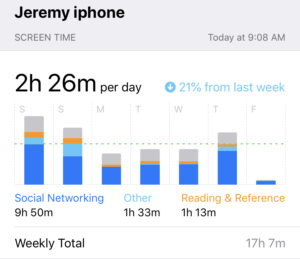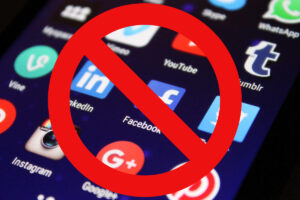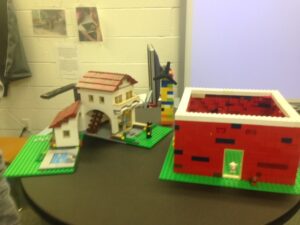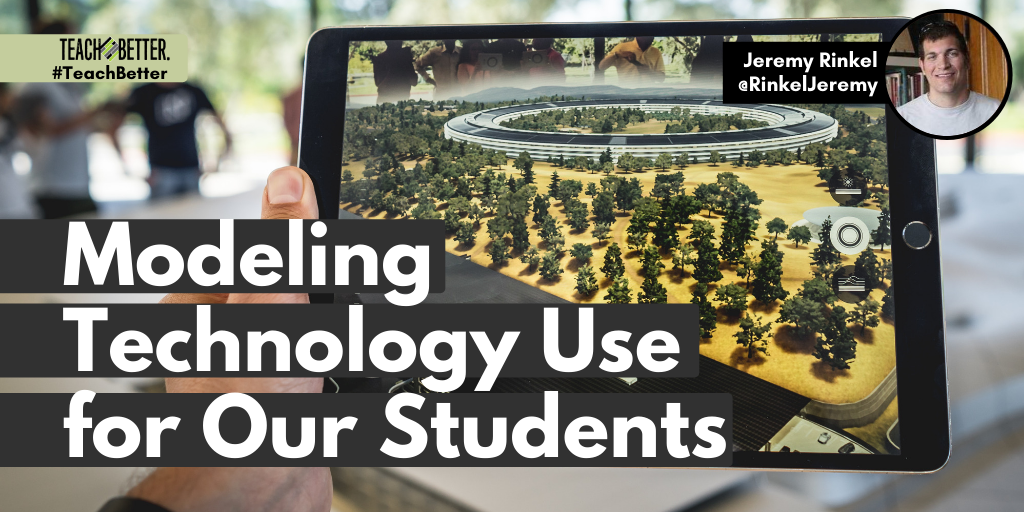In This Post:
- The problem with student technology use… and overuse.
- Tools to become more aware of technology use for students and adults.
- Alternatives to technology in the classroom and at home.
- Three ways to balance technology use in your and your students’ lives!
I recently had a conversation with a student about technology use that went a little something like this…
Student: “Mr. Rinkel! My average screen time last week was 11 hours a day!“
Me: “11 hours for the week or 11 hours a day?!?!“
Student: “11 hours a day. The Screen time app showed I spent 14 hours on my phone on Saturday.“
Me: “Wow! How are you spending that much time on your phone? Were you making movies, editing pictures, blogging or reading?”
Student: “Nope! Just on SnapChat and Instagram.”
This conversation is the inspiration behind this post. Our lives revolve around the use of technology. I spend 24 hours a day with teenagers, if you count my own children. My children don’t know how to act when the WiFi goes offline for even a few seconds.
They’re literally running to the modem to see if the “light is red.” I value and understand the importance of technology for our teens’ futures, but also see the need to help encourage and assist my children and students to create a balance with their technology use. How can we best model the balance of technology use at home and in the classroom?
It is what we do with our technology awareness that creates the balance in our lives. Click To Tweet1. Be Aware of Daily Technology Use
Technically, before a strategy can be put into place to decrease or manage technology use, we have to become aware of our usage.

Note: Facebook was deleted off my phone on Saturday of the week of this screen shot was taken on my phone. Notice a 21 percent decrease in screen time so far.
One element to creating awareness is knowing the trends and research studies (See PEW Research Study on Teens Social Media and Technology Use) of our smart phone usage. With access to Chromebooks, phones (although they are supposed to be kept in lockers), drones and other technology, I think it’s important to slow down and allow time away from technology. I’ve challenged students to keep track of and log their daily usage using an app or manually logging it.
Here is a list of possible apps you can download on your Smartphone: Screen Time (IOS), Moment, Space , Offtime, App Detox (Android), and Breakfree.
It is what we do with our awareness that creates the balance in our lives.
In my classroom, I plan lessons that require no technology at least two days a week. Due to my love of technology, I have to be intentional as a teacher to implement the non-tech days. Some days we read from textbooks or novels instead of viewing websites and Youtube videos.
I also have students create non-tech objects with Playdoh, paper, wood, cardboard and other materials. Having students create in this way is difficult for them as they have trouble coming up with ideas without asking “Mr. Google.” They complain it’s hard to come up with their own idea and that “nothing is original anyway.”
2. Provide Alternatives at Home and the Classroom
At Home
My wife and I have tried a variety of ways to teach technology balance in our home, but let’s face it, as adults we struggle putting our phones and laptops down. Having an awareness is a start, but implementing practices takes intention and a whole lot of patience when modeling behaviors we desire for our children and students.
 Create Device Free Zones
Create Device Free Zones
We also implement “device free zones” inside and outside our home. Any time we are eating at home or with friends or family members, the table is a device free zone. Occasionally, conversation requires a question to be answered by “Mr. Google”, but the device is put away after a question is answered. This comes back to modeling behavior.
At a holiday party, my father noticed I wasn’t on my phone as much as I usually am. He even made the comment, “Is your phone broke or something?” Being attentive and present is something adults must model for our children and students if we are to create a healthy technology balance.
In the Classroom
With some studies finding that nearly 70 percent of jobs involve technology, I struggle to balance preparing students with technology versus instructing and teaching with too much technology. As an adult, modeling behavior goes a long way when working with children. It can be simple, like not constantly checking your email, phone, or other devices. Discuss the importance of “unplugging” even though students will look at you like you’re crazy.
Provide Opportunities to Create

Every student has a “locked up” Kindergartner in them. What I mean is that nearly 100 percent of young kindergartners see themselves as skilled in whatever the teacher asks about being good at. For example, if a teacher asks if you are a good painter, nearly all the hands go into the
air. Our older students hide or suppress these skills out of fear of what others think.
Most Thursdays in my classroom have became what my students call “Creative Thursdays.” On creative Thursdays, my students are required to create something without the aid of a technological device. They can draw, sculpt, build, and paint objects. With five minutes left in the class period, I have the students complete a reflection question based on their creation.
Provide Opportunities to Move
Students spend the majority of their days sitting at a desk. Allowing students to get up and move not only benefits them physically but also mentally. Some of my units require movement from station to station within my classroom. Each station has a particular activity. Taking students outside on a nice day for a walk around campus is good for the soul. It also can stimulate creativity when writing descriptive paragraphs.
[scroll down to keep reading]3. Turn Off Notifications
The easiest way to reduce screen time is to turn off unnecessary notifications. I keep my iMessage and texting app notification on, but everything else is turned off. My Facebook, SnapChat, Twitter, and Instagram notifications can wait. It’s important for me to be more present with my family at home.
As a way for myself to decrease technology time, I recently deleted the Facebook app from my phone, freeing up hours of time for me to do other things.
Sorry Mark Z!




